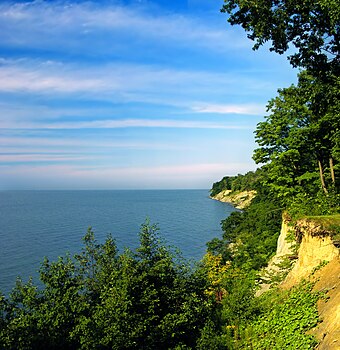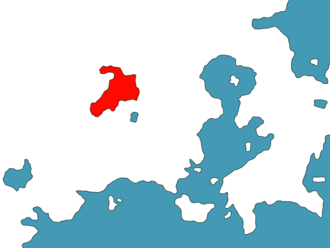Lake San Salvador
| Lake San Salvador | |
|---|---|
 | |
 | |
| Location | Central Sur |
| Group | Great Creeperian Lakes |
| Coordinates | |
| Type | Tectonic lake |
| Native name | Լագո Սան Սալվադոր – Lago San Salvador |
| Etymology | "Lake of the Holy Savior" in Creeperian Spanish |
| Primary inflows | San Miguel River |
| Primary outflows | Asambio River |
| Basin countries | |
| Designation | Creeperopolis National Historical Landmark |
| Surface area | 38,623 ml.2 (25,644 mi.2; 66,417 km.2) |
| Max. depth | 2,832 pi. (2,589 ft.; 789 m.) |
| Residence time | 284 years |
| Islands | 28 (see list) |
| Settlements | Bautista, Escuinbulco, La'Mirada, La'Unión, La'Victoria, Nuevo San Salvador, San Salvador, San Salvador del Norte, South Serrada, Terrarote |
Lake San Salvador (Creeperian Spanish – Creeperian: Լագո Սան Սալվադոր; Creeperian Spanish – Iberic: Lago San Salvador) is the second largest lake in the world by surface area and the largest in both Sur and Creeperopolis by surface area. The lake is located in central Creeperopolis and is categorized as a member of the Great Creeperian Lakes group.
Contents
Etymology
The name of the lake, "Lake San Salvador," means "Lake of the Holy Savior" in Creeperian Spanish, in reference to Jesús Cristo, the central figure of Christianity and the Creeperian Catholic Church. In Creeperian Spanish, the name of the lake is "Լագո Սան Սալվադոր" in the Creeperian Script and "Lago San Salvador" in the Iberic Script.
The lake was also previously known as "Buhayrat Alrasul" (بحيرة الرسول), meaning "Lake of the Messenger" in Arabic, in reference to Muhammad, the central figure of Islam. from the 10th century to the 14th century. It was also known as "Lake Victory" (Lago Victoria) from the 14th century until the mid-15th century, when it became known as Lake San Salvador.
Geography
Lake San Salvador is the second largest lake in the world after Lake Cronan in central Ecros, and it is the largest lake in Sur and the southern hemisphere. Being the second largest fresh water lake in the world, Lake San Salvador, holds 8% of the world's fresh water.
Islands
The lake has twenty-eight islands, with the largest being Isla San Romero, which itself has two lakes on it with one of the lakes containing an island. All of the islands of Lake San Salvador in order of largest to smallest are:
- Isla San Romero
- Isla de la'Gran Victoria
- Isla Puyal Cisneros
- Isla Bendita
- Isla San Salvador
- Isla Santa Ana
- Isla Punto Norte
- Isla del Santo Bautista
- Isla Miguel I
- Isla de Jesús
- [[
- [[
- [[
- [[
- [[
- [[
- [[
- [[
- [[
- [[
- [[
- [[
- [[
- [[
- [[
- [[
- [[
- [[

